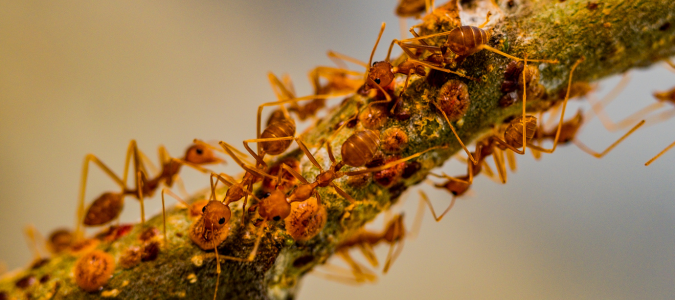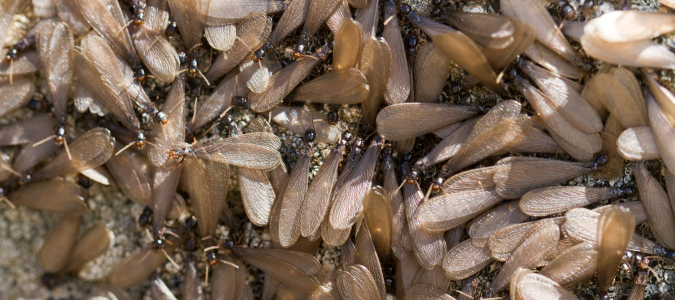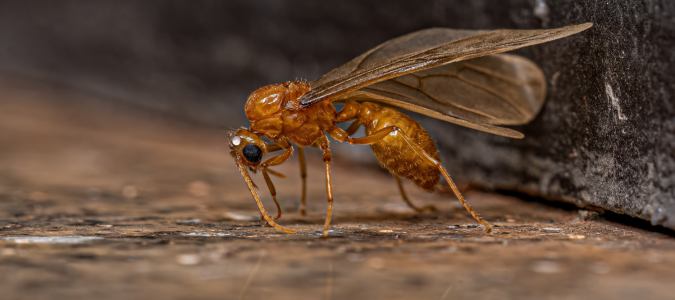If you have pesky ants at home, you know how they can feel impossible to control. Since it can seem like they are always around, many homeowners wonder how many ants are in a colony.
If ants are invading your space, contact pest control specialists. Ants are hardworking and resilient pests but are no match for the pros. They have the tools and expertise to control these pests and help prevent future colonies from invading.
How Many Ants Are in a Colony?
Ants are social insects, and each of them belongs to a colony. Unlike other insects, you’ll never find an ant that operates solo. These colonies come in different sizes depending on species, colony age, climate and other factors.
The number of ants in a colony can vary depending on the species, age of the colony and the weather. Most ant colonies will have a few hundred ants, while some ant species, like fire ants, can have 100,000 to 500,000 worker ants in addition to winged ants and a queen.
Where Do Ants Build Their Nests?
So, where do ant colonies build their nests? Smaller groups usually make do with natural cracks and openings. Meanwhile, larger colonies build massive nests and forage for food and materials. First, they burrow into the ground or find a spot under a rock or fallen tree. They will start with a small nest, expanding slowly as their colonies grow.
Ants are talented architects. Their nests can get very large and intricate, featuring tunnels and chambers. Homeowners can identify ant colonies on their property by looking for small mounds. The ants use these as entry and exit points for their nests.
Ants come into our homes to look for water and food. They can enter through the tiniest cracks and gaps, so it’s important to seal off any openings. While ants are typically not dangerous, they’re a terrible nuisance. If they’re causing you unnecessary stress, let pest control specialists help. They will apply the best solution to control these pests and restore peace in your home.
Termite Versus Ant Wings: How Can You Tell the Difference?
It’s more common to see flying ants and termites during certain parts of the year. In the late summer, queens and winged males, pictured above, will scatter and mate. You’ll see the large queens and the smaller males in the air doing their nuptial flight. They swarm in great numbers to boost their chances of reproduction with a suitable mate.
Termites have a similar practice that occurs when their colony reaches maturity. Their colonies produce winged reproductive males and females called swarmers. These swarmers leave their nests to find mates and build their own colonies. They swarm in the spring, usually after a rainstorm.
After finding their partner and mating, the swarmers will fall to the ground and lose their wings. They are then ready to find a new spot in the ground for their colony.
Wing and Appearance Differences
If you’re unsure whether you have flying ants or termites on your property, the wings are a good determinant. Many homeowners wonder, do termites look like ants? Flying ants, pictured above, sport two pairs of brownish wings that differ in size. Meanwhile, termites have two pairs of transparent wings that are equal in length. Both flying ants and termites will drop their wings after mating.
Flying ants and termites have other differences in appearance. Flying ants have a pinched waist, a brown, black or red body and bent antennae. On the other hand, termites have a broad body and can be black, dark brown or creamy white in color, based on the type of termite. They also have a straight antennae.
Behavioral Differences
Termites have a penchant for wood, eating away at tree stumps, rotten wood, wooden debris and wooden parts of any structure. They can cause severe structural damage to a house. While some species of ants, like carpenter ants, live in wood, they don’t consume it.
While termites feed on cellulose-based products like wood and paper, ants prefer a more nutrient-rich diet. These omnivorous insects live on seeds, nectar and other insects. Any food they find inside our homes is suitable for them.
Worker ants only have a few months to live, while the queens can thrive for years. Termites tend to live longer. Most survive a few years, while their queens can go on for decades.
Contact the Pros to Help With Insect Infestations
Insect infestations are difficult to deal with on your own. Not only are ants, mosquitoes and termites annoying, but they can also cause itchy bites. Termites can even cause structural damage to your home.
Contact pest control specialists if you notice these insects in your home or around your property. The pros will know how to treat them. They can also perform regular maintenance checks to help protect your family from insects and other pests.
ABC Can Control and Prevent Ants
Dealing with an ant problem can be extremely frustrating. Instead of trying to prevent or control ants on your own, contact ABC Home & Commercial Services. Our highly trained pest control professionals will create a custom treatment plan, so you don’t have to worry about any type of ants, including fire ants.



